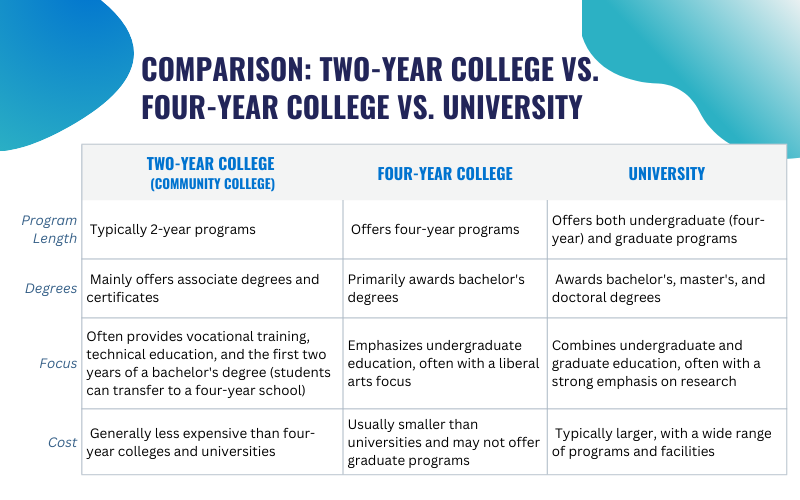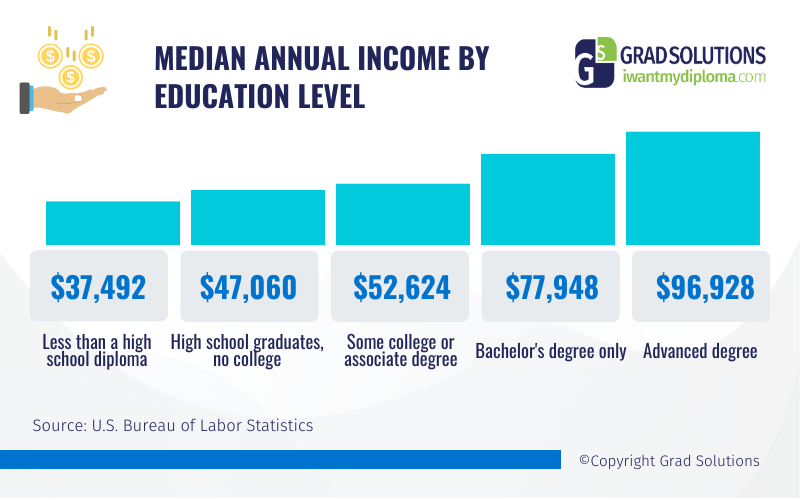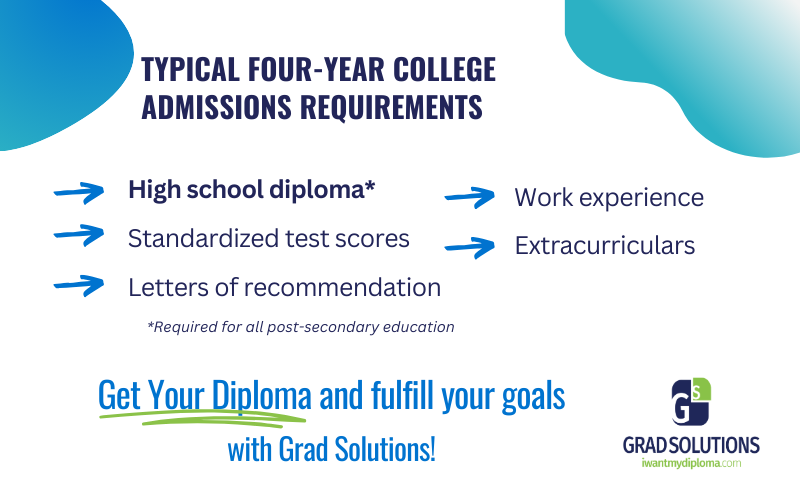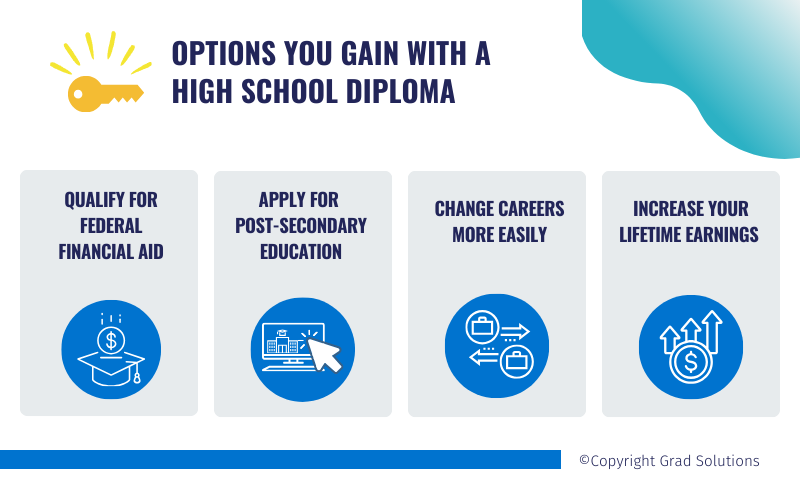Program Information
Can you go to college without a high school diploma?

Deciding on your next steps after high school can be exciting and overwhelming. With numerous options for higher education, finding the path that best suits your interests, goals, and circumstances is crucial. Some postsecondary education choices include four-year universities, vocational schools, and trade schools. This article will examine their differences and what it takes to get accepted into each option.

What’s the difference between a Community College, a Four-Year College, and a University
Two-Year College
When considering higher education, it’s essential to understand the differences between a two-year college, a four-year college, and a university. A two-year college, often called a community college or junior college, typically offers associate degrees and certificate programs. These institutions are known for their accessibility, affordability, and flexible class schedules, making them an excellent choice for students looking to enter the workforce quickly or transfer to a four-year degree program.
Four-Year College
A four-year college journey, on the other hand, primarily offers students a bachelor’s degree. These colleges provide a more traditional college experience, with a broader range of academic disciplines and extracurricular activities. Students at four-year colleges can immerse themselves in a campus environment, often with opportunities for residential living, student organizations, and athletics. The focus at these institutions is on providing a comprehensive undergraduate college education, preparing students for various professional development or advanced studies.
University
Universities are larger institutions offering undergraduate and graduate degrees, including master’s and doctoral programs. They are typically composed of multiple colleges or schools specializing in different academic fields, such as:
- Business
- Engineering
- Arts and Sciences
- Education
Universities often emphasize academic skills like research, offering extensive facilities and resources for students and faculty to engage in scholarly activities. This setting provides a dynamic and diverse environment, attracting students from all over the world and offering various academic and professional opportunities.
In essence, two-year colleges focus on shorter programs and vocational training, four-year colleges focus on undergraduate education, and universities provide a full range of undergraduate and graduate programs, often with a research component.
Understanding these differences can help you choose the educational opportunities that best align with your goals, whether you seek a quick entry into the workforce, a comprehensive undergraduate education, or advanced academic and professional pursuits.
In this blog, we’ll focus on answering a common question that many teens and their families ask to help you make informed decisions about your future education and career pathway. Let’s dive in and explore the options available for those considering higher education.

College Admissions Requirements
Understanding the differences in enrollment requirements between two-year colleges, four-year colleges, and universities is crucial for high school students as it allows them to adequately prepare and tailor their academic and extracurricular activities accordingly. Recognizing these differences early helps students set realistic goals, choose the right courses to help them prepare, and build a robust application profile, increasing their chances of admission to their preferred institution.
Enrollment Requirements for a Two-Year College (Community College)
Two-year colleges often have more accessible admission criteria, typically requiring an ID and placement test, making them an appealing option for students seeking a flexible and cost-effective education. Some students who attend a two-year college transfer to a four-year college or university to earn a bachelor’s degree.
Here is a list of the general requirements to enroll in a two-year college:
- Application Form: Applicants must complete an application form on the college’s website.
- Residency Requirements: Proof of residency may be required to qualify for in-state tuition rates.
- Placement Tests: Many community colleges require placement tests in subjects like Math and English to determine the appropriate course levels.
- Transcripts: Submit high school transcripts, GED test scores, or other college transcripts for prior college coursework completed. These are used for placement purposes.
- Federal Financial Aid Forms: If you are seeking financial assistance, complete financial aid forms such as the FAFSA (Free Application for Federal Student Aid).
Admission requirements vary by school, but many community colleges require applicants to submit a high school diploma or GED certificate. In general, getting to high school graduation provides the foundational knowledge to succeed in college.
Vocational Program Requirements
While the general enrollment requirements at two-year colleges are few, vocational programs often have additional requirements to be admitted. Programs like Nursing, Phlebotomy, Cosmetology, and commercial truck driving usually require a high school diploma OR a (GED diploma). In states like Arizona, becoming a licensed professional in vocations like nursing, massage therapy, realty, trucking, etc., requires you to be a high school graduate or complete a high school equivalency like the GED.

Enrollment Requirements for a Four-Year College and Universities
Four-year colleges and universities, on the other hand, have more stringent enrollment requirements than a two-year college. These requirements often overlap but can differ in certain aspects. For those looking to enroll and work toward a bachelor’s degree, the requirements often include letters of recommendation, personal essays, and evidence of extracurricular involvement, reflecting their more competitive and comprehensive academic environments.
Their admissions office might require higher standardized test scores, more detailed and multiple personal essays, and a stronger emphasis on leadership roles and community service. Universities often offer a broader range of programs, including graduate and professional degrees, which can add complexity to their admissions process.
Some undergraduate programs may also require interviews or portfolios, particularly for specialized or competitive fields like the Arts. Understanding these nuances allows applicants to tailor their preparations and meet the specific demands of their chosen institution.
Here is a list of the typical requirements to enroll in a four-year college or university:
- High School Diploma or GED: A high school diploma or GED is required.
- Application: Complete the college’s application form online.
- Transcripts: Submit high school transcripts.
- Letters of Recommendation: Some colleges require letters of recommendation from teachers or counselors.
- Personal Essay: A personal essay or statement is often required to assess the applicant’s writing skills and personality.
- Extracurricular Activities: Information about involvement in extracurricular activities, leadership roles, and community service.
- Standardized Test Scores: Some schools require SAT or ACT scores.
- Application Fee: Pay an application fee.
- Interview: Some programs may require an interview.
- Financial Aid Forms: Complete financial aid forms like the FAFSA.
These requirements can vary by institution, so it’s essential to check the specific admissions criteria for each college or university.
Vocation and Trade School Requirements
The admission requirements for vocation or trade programs can vary, especially from program to program. However, a high school diploma or GED exam is often needed to be admitted since many trades or vocations have these as state licensure requirements.

Grad Solutions: A Stepping Stone for Your Future
For Arizona residents ages 16-21 looking to complete their high school education, Grad Solutions offers the opportunity to earn a high school diploma online for free and improve future options. Grad Solutions is dedicated to helping students who have left high school or are at risk of not graduating by providing a flexible and supportive educational program tailored to their needs.
To qualify for Grad Solutions, prospective students must be Arizona residents, 16 and 21 years of age, and still need to earn a high school diploma. If you’re ready to take the next step toward a brighter future, learn more about Grad Solutions or enroll today. This program could be the key to unlocking higher education and achieving your dreams.
Resources:
https://studentaid.gov/h/apply-for-aid/fafsa
https://www.bls.gov/emp/chart-unemployment-earnings-education.htm